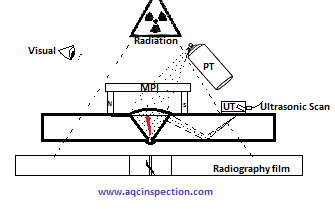The Role of Welding Assessment in Averting Failings and Enhancing the Longevity of Welded Structures and Components
Welding examination is an important part in the lifecycle of welded structures, functioning as a positive measure against potential failures that can endanger security and performance. By systematically determining problems such as porosity or incomplete fusion, assessors can considerably enhance the long life of crucial parts. The application of diverse examination strategies not just makes sure compliance with sector standards but additionally cultivates a robust society of quality assurance. Nevertheless, the implications of neglecting this vital technique can be extensive, questioning concerning the real influence on architectural honesty and long-lasting efficiency. What are the most effective practices that can better elevate assessment effectiveness?
Importance of Welding Assessment
Welding assessment serves as a vital guard in the stability of bonded frameworks, making sure that they meet strict security and high quality requirements. The relevance of this process can not be overemphasized, as it plays a vital duty in identifying possible issues before they escalate into tragic failures. By carefully evaluating welds, examiners can confirm adherence to make specs and regulative requirements, consequently mitigating threats related to structural compromise.

Moreover, efficient welding evaluation boosts the durability of components, as it permits the very early discovery of flaws that might bring about damage gradually. This positive strategy not only extends the service life of welded structures but additionally promotes dependability and functional efficiency. In industries such as construction, aerospace, and automotive, where safety and security is critical, the assessment process is important.
Additionally, welding inspection promotes a culture of top quality guarantee within companies, motivating adherence to best practices and continuous enhancement. By purchasing comprehensive inspection procedures, companies can enhance their reputations and preserve client trust. Inevitably, the significance of welding evaluation exists in its capacity to copyright safety, high quality, and longevity in welded frameworks, making it a fundamental part of engineering stability.
Typical Welding Problems
Several typical welding problems can jeopardize the integrity of bonded frameworks, leading to possible failures otherwise addressed. Amongst these defects, porosity is just one of one of the most prevalent, characterized by the existence of small gas pockets entraped within the weld steel. This can substantially deteriorate the joint, leading to minimized structural stability.

An additional issue is incomplete blend, which takes place when the weld metal stops working to adequately fuse with the base material or previous weld layers. This lack of bonding can produce powerlessness that might stop working under tension. Absence of penetration refers to inadequate deepness of weld metal, preventing the joint from achieving its designated toughness.
Fractures can additionally develop throughout the welding procedure, often because of rapid cooling or improper welding criteria. These fractures might circulate under load, leading to catastrophic failures. Furthermore, extreme spatter can hinder the weld's top quality by introducing impurities.
Evaluation Approaches and techniques
Effective assessment methods and approaches are essential for ensuring the stability and longevity of welded structures. A thorough evaluation program utilizes a range of non-destructive testing (NDT) techniques to spot possible problems without compromising the welded components. Among the most commonly made use of strategies are visual examination, ultrasonic screening, radiographic testing, magnetic bit screening, and color penetrant testing.
Aesthetic assessment functions as the first line of protection, enabling assessors to identify surface flaws such as splits, misalignments, or insufficient combination. Ultrasonic screening uses high-frequency sound waves to discover internal defects, supplying comprehensive info regarding try this web-site the product's honesty. Radiographic screening uses X-rays or gamma rays to visualize the inner structure of welds, allowing the identification of inclusions and voids.
Magnetic bit testing works for discovering surface area and near-surface suspensions in ferromagnetic products, while color penetrant testing highlights surface-breaking flaws utilizing colored dyes. Each approach has its distinct benefits and limitations, requiring a calculated combination to achieve thorough evaluation protection. Carrying out these strategies methodically ensures that any type of prospective concerns are recognized early, cultivating the integrity and resilience of bonded frameworks.
Influence On Architectural Honesty
The stability of a structure is significantly affected by the top quality of its bonded joints, as they function as crucial points of strength and security. Poorly implemented welds can result in stress focus, exhaustion failings, and ultimately, devastating architectural collapse. The reliance on welding as a key means of signing up with products demands rigorous evaluation protocols to ensure that welds meet recognized requirements and requirements.
Deficiencies in weld high quality, such as incomplete blend, fractures, or porosity, can endanger the mechanical residential or commercial properties of the joint, impacting load-bearing capacity and overall efficiency. When these issues go undetected, they can circulate under functional anxieties, bring about a reduction in architectural honesty gradually. Thorough and routine inspections are vital in identifying these weaknesses prior to they escalate into considerable failures.
Moreover, the influence of ecological variables, such as deterioration, can be worsened by poor welding practices. Thus, ensuring top quality welding via alert evaluation not only advertises immediate structural dependability however additionally extends the service life of components. Welding Inspection Milwaukee. Inevitably, the financial investment in proper welding assessment is a necessary method for securing against architectural failures, thus enhancing the long life and security of bonded structures

Finest Practices for Effective Examination
Applying organized examination methods is important for ensuring the integrity of welded joints. Effective evaluation starts with the development of thorough lists customized to the details welding procedures and products entailed. These checklists ought to encompass aesthetic examinations, non-destructive testing (NDT) methods, and paperwork testimonial to ensure that all elements of the welding procedure are looked at.
Training and qualification of examination employees are critical elements of an effective inspection program. Examiners should be fluent in different NDT techniques, consisting of ultrasonic, radiographic, and magnetic particle screening, to precisely identify problems such as cracks, porosity, and insufficient combination.
Timely examinations need to be scheduled at various stages of the welding procedure-- pre-weld, during welding, and post-weld-- to capture any potential concerns early. Additionally, keeping detailed documents of inspections fosters accountability and facilitates future examinations.
Conclusion
Welding inspection is vital for identifying defects and making sure the integrity of bonded frameworks. By utilizing different inspection published here methods, potential concerns can be discovered early, consequently preventing catastrophic failures and boosting the longevity of parts. The implementation of best techniques in assessment promotes a culture of top quality assurance, making sure conformity with layout specs explanation and governing criteria. Ultimately, efficient welding evaluation not only safeguards structural integrity but also contributes substantially to the general integrity and sturdiness of welded joints.
Welding inspection is a necessary component in the lifecycle of welded frameworks, offering as a positive step against possible failings that can compromise safety and capability.Welding inspection offers as a critical safeguard in the integrity of bonded structures, ensuring that they meet rigorous safety and top quality requirements. Welding Inspection Milwaukee. Eventually, the significance of welding evaluation exists in its capacity to maintain safety, quality, and longevity in welded frameworks, making it a fundamental part of design integrity
Ultimately, the financial investment in proper welding examination is an essential technique for safeguarding versus structural failings, thereby enhancing the durability and safety of bonded frameworks.
Welding examination is important for identifying problems and making certain the stability of welded frameworks. Welding Inspection Milwaukee.